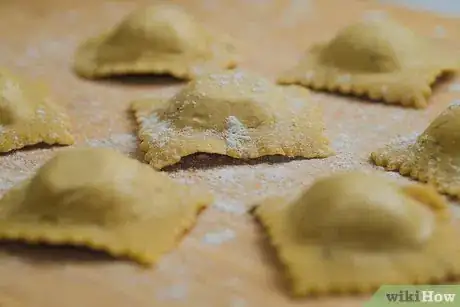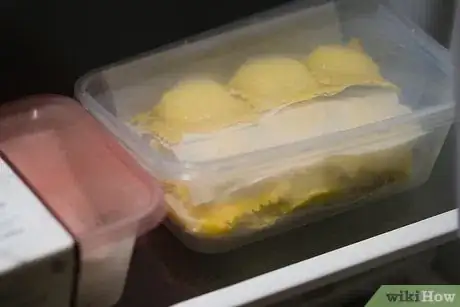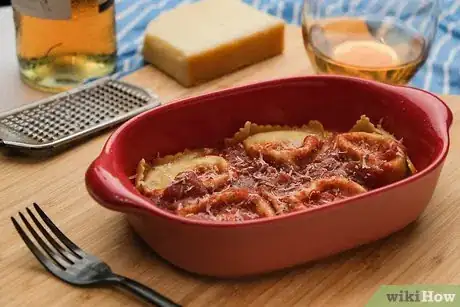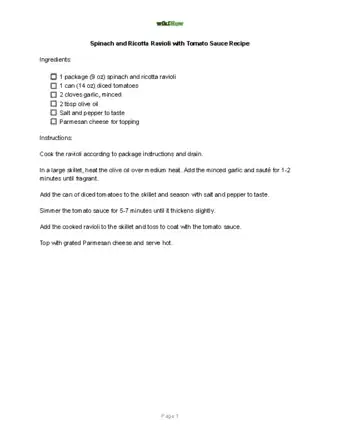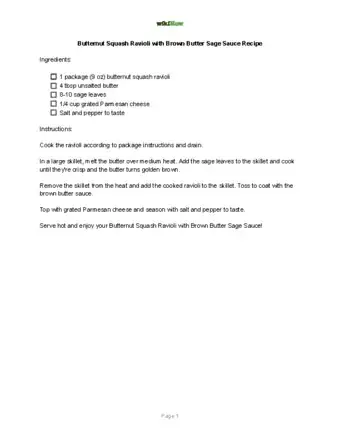This article was co-authored by wikiHow Staff. Our trained team of editors and researchers validate articles for accuracy and comprehensiveness. wikiHow's Content Management Team carefully monitors the work from our editorial staff to ensure that each article is backed by trusted research and meets our high quality standards.
The wikiHow Culinary Team also followed the article's instructions and verified that they work.
This article has been viewed 308,098 times.
Learn more...
Ravioli is a simple, classic pasta dish that's easy to cook and easy to portion. You can prepare a batch within a matter of minutes. Read on to learn how to cook ravioli!
Ingredients
- 2-6 quarts of water
- Ravioli, fresh or frozen
Steps
Preparing and Storing
-
1Get your ravioli. Buy or otherwise acquire a package of uncooked ravioli. Try the refrigerated or frozen pasta section of your grocery store.
- If you have any special dietary requirements, be careful which ravioli you buy. Ravioli is often stuffed with cheese, meat, or both, although you should be able to find non-meat and non-dairy varieties. The dough is usually made from wheat flour unless stated otherwise.
-
2Consider making your own ravioli. You can prepare a simple cheese-filled ravioli in just a couple of hours. You will need to make or prepare the filling, mix and shape the dough, and wrap the filling into the dough.[1]Advertisement
-
3Store uncooked ravioli in the refrigerator or freezer. Ravioli keeps best when it is cool. If you aren't cooking your ravioli immediately, place into an airtight container and store it in the refrigerator. If you don't plan to cook the pasta within a week, store it in the freezer in an airtight container. Frozen ravioli should be used within 30-45 days of purchase.
-
4Prepare ravioli to cook. If you are storing the pasta in the freezer or refrigerator, take it out immediately before you cook it. Cut fresh or refrigerated ravioli apart with a sharp knife to keep the pieces from sticking together in the pot.
- Do not try to thaw frozen ravioli. Put it into the pot while it's still frozen.
Cooking the Ravioli
-
1Boil water. Fill a pot with 2–6 US quarts (2,000–6,000 ml) of cold water (per pound of pasta). Then, bring the water to a boil. Make sure that the pot is large enough to hold all of the pasta that you're making.[2]
- Be sure to place a lid on the pot. This will help retain the steam—the heat and the moisture—and make the ravioli cook more quickly.
- Most ravioli recipes call for 4–6 US quarts (4,000–6,000 ml) of water to each pound of ravioli. Extra water quickly recovers the boil when the pasta is added; gives the noodles room so that they don't stick to one another; and dilutes the starch that they release, so they don't end up with a “gluey” texture. Feel free to use less water, however, as long as there's enough to submerge the ravioli.[3]
-
2Cook the ravioli. Once the water begins to boil, put the ravioli into the pot. Follow the boiling instructions on the package. If there are no instructions on the package: cook at a boil for 4-6 minutes, or until the pasta begins to float. When a piece of pasta floats to the surface, it's ready.[4]
- Salt the water to taste. As a rule of thumb, add one teaspoon of salt for each quart of water that you use. Consider adding olive oil to the water to keep the pasta from sticking: again, about a teaspoon of oil per quart of water.
-
3Stir the pot. Use a ladle or stirring spoon to swirl the water periodically as the pasta cooks. Separate any ravioli dumplings that are sticking together.
-
4Know when your ravioli is done. The ravioli should puff up and become whiter as the dough cooks. Some people like their pasta soft and fully-cooked. Other people like their pasta slightly harder and undercooked, or "al dente". Ravioli dough contains eggs, unless stated otherwise, so it is important to cook it thoroughly to avoid salmonella poisoning. Remember that larger ravioli will quick more slowly, and smaller ravioli will cook more quickly.
- If the ravioli begins to look bloated, or begins to come apart, then it may be slightly overcooked.
- Taste your ravioli throughout the cooking process. This is the best way to tell when it's ready. Nibble on the edge of a ravioli piece to discern whether it's done. If the ravioli is still at all cold or frozen, keep cooking. If the ravioli tastes doughy or floury, it may not be done.
-
5Drain the ravioli. If you have a colander or a pasta strainer, place it into the sink or any area that will allow the water to drain. Pour the contents of the pot—ravioli and water—into the strainer so that the water flows away, but the pasta remains. Pour slowly, and be careful not to lose any pasta.
- If you don't have a pasta strainer, pour the water out of the pot while keeping the pasta within. Tilt the pot sideways so the water trickles out the top. Hold the lid of the pot over the opening to hold back the pasta. Leave a tiny crack between the lid and the rim of the pot so that the water can slip through, but the ravioli cannot.
- Pour the water into the sink to dispose of it, or use it to water your garden. If you drain the pasta into another bowl or pot, you can carry the extra water outdoors and reuse it.
Serving the Dish
-
1Let the ravioli cool. It should be ready to eat within five minutes. Eat it as soon as it doesn't burn your mouth. Place the ravioli into a large bowl, and serve!
-
2Serve ravioli with your favorite sauce. Common choices include tomato sauce, marinara, pesto, and alfredo. Consider heating the sauce in a saucepan for several minutes, on a low heat, before serving.
- You can pour the sauce over the ravioli, or you can keep the sauce in a separate bowl. The latter option will allow each diner to portion their own sauce.
-
3Consider food and drink pairings. Consider serving ravioli with cooked vegetables, chicken or fish, fresh bread, and an Italian wine. Have fun with it, and don't be afraid to make the meal a cultural experience!
- Eat ravioli with a fork. Serve it with a ladle or a large spoon.
Recipes
Community Q&A
-
QuestionDoes fresh ravioli need to be boiled for 4 minutes?
 Community AnswerRavioli and other filled pastas should be put into boiling water and cooked until they float.
Community AnswerRavioli and other filled pastas should be put into boiling water and cooked until they float.
Warnings
- Be careful when you put the ravioli into the pot of boiling water. Gently slide the dumplings into the water with a spoon or a ladle. If you dump the ravioli in quickly, boiling water may splash up out of the pot and scald you.⧼thumbs_response⧽
- Be careful if you have celiac disease or you are lactose-intolerant. Ravioli contains gluten unless stated otherwise, and most ravioli is filled with some type of cheese.⧼thumbs_response⧽
Things You'll Need
- Cooking pot
- Stovetop
- Ladle or stirring spoon
- Colander or strainer (optional)
References
About This Article
One easy way to cook ravioli is by boiling it. First, bring 4 quarts (4.5 L) of water for every 1 pound (0.5 kg) of ravioli you’re making to a boil. Then, add the ravioli to the water and stir to keep the ravioli separated. Let the ravioli cook for 4-6 minutes or until they float to the surface of the water. Then, drain the ravioli in a colander and add your sauce. You can also cook ravioli in the microwave. Place the ravioli in a microwave-safe dish and add ½ cup (118 mL) of sauce and ¼ cup (59 mL) of water for every 5 pieces of ravioli you’re cooking. Cover the dish with parchment paper and microwave the ravioli on high for 2 minutes. Then, take the cover off and stir the sauce into the ravioli. Put the parchment paper back on and heat the ravioli for 2 more minutes. Another delicious option is to bake ravioli. Start by preheating your oven to 350 °F (175 °C). Then, coat a baking dish with a thin layer of non-stick cooking spray. Set the ravioli in the baking dish and pour your sauce over them. Finally, cover the dish with aluminum foil and bake the ravioli for 55 minutes. For tips on how to pair ravioli with other foods, like meat or vegetables, read on!

